Do you have a question about the Elektra Beckum TKHS 315 C and is the answer not in the manual?
Defines the intended use of the machine for cutting wood materials and warns against misuse.
Provides essential safety guidelines for operating the machine, including work area, personal protection, and alertness.
Explains the meaning of symbols found on the machine's nameplate.
Details the function and importance of safety features like the riving knife and blade guard.
Highlights key features such as adjustable bevel tilt and depth of cut, and robust construction.
Identifies and explains the function of the machine's controls like the ON/OFF switch and adjustment cranks.
Provides step-by-step instructions for assembling the saw stand, including legs and stanchions.
Instructions for safely connecting the machine to the power supply, emphasizing voltage and safety requirements.
Guidance on placing the machine on a firm floor and ensuring sufficient space for operation.
General operational guidance, safety checks before starting, and personal protection gear recommendations.
Guidelines for using dust collection systems, including requirements and conditions for use.
How to adjust the saw blade's cutting depth for different workpiece thicknesses safely.
Instructions for adjusting the saw blade angle for bevel cuts, ensuring safety during adjustment.
Procedure for using the rip fence to make straight cuts along the length of the workpiece.
Instructions for using the mitre fence to make cross cuts and angled cuts accurately.
Provides advice for trial cuts, workpiece positioning, using supports, and cleaning surfaces.
Step-by-step guide for safely replacing the saw blade, including precautions and tool usage.
Procedure for cleaning the saw blade's height adjustment spindle for smooth operation.
Guidelines for safely storing the machine to prevent unauthorized use and injury.
Routine maintenance checks before and after operation, including visual inspections and cleaning.
Information on where to send tools for repair and the importance of qualified technicians.
Instructions for safely transporting the machine, including lowering the blade and removing parts.
Lists optional accessories available for enhancing the machine's functionality.
Information regarding the recyclability of the machine's packaging and components.
Guides users through common problems like motor not running or loss of cutting performance.
Provides detailed technical data for the machine, including voltage, power, dimensions, and sound levels.
Defines the intended use of the machine for cutting wood materials and warns against misuse.
Provides essential safety guidelines for operating the machine, including work area, personal protection, and alertness.
Explains the meaning of symbols found on the machine's nameplate.
Details the function and importance of safety features like the riving knife and blade guard.
Highlights key features such as adjustable bevel tilt and depth of cut, and robust construction.
Identifies and explains the function of the machine's controls like the ON/OFF switch and adjustment cranks.
Provides step-by-step instructions for assembling the saw stand, including legs and stanchions.
Instructions for safely connecting the machine to the power supply, emphasizing voltage and safety requirements.
Guidance on placing the machine on a firm floor and ensuring sufficient space for operation.
General operational guidance, safety checks before starting, and personal protection gear recommendations.
Guidelines for using dust collection systems, including requirements and conditions for use.
How to adjust the saw blade's cutting depth for different workpiece thicknesses safely.
Instructions for adjusting the saw blade angle for bevel cuts, ensuring safety during adjustment.
Procedure for using the rip fence to make straight cuts along the length of the workpiece.
Instructions for using the mitre fence to make cross cuts and angled cuts accurately.
Provides advice for trial cuts, workpiece positioning, using supports, and cleaning surfaces.
Step-by-step guide for safely replacing the saw blade, including precautions and tool usage.
Procedure for cleaning the saw blade's height adjustment spindle for smooth operation.
Guidelines for safely storing the machine to prevent unauthorized use and injury.
Routine maintenance checks before and after operation, including visual inspections and cleaning.
Information on where to send tools for repair and the importance of qualified technicians.
Instructions for safely transporting the machine, including lowering the blade and removing parts.
Lists optional accessories available for enhancing the machine's functionality.
Information regarding the recyclability of the machine's packaging and components.
Guides users through common problems like motor not running or loss of cutting performance.
Provides detailed technical data for the machine, including voltage, power, dimensions, and sound levels.
| Power | 2.0 kW |
|---|---|
| Voltage | 230 V |
| Blade Diameter | 315 mm |
| Saw Blade Bore | 30 mm |
| Max Cutting Height/Depth at 90° | 85 mm |
| Cutting Depth at 45° | 60 mm |
| Table Size | 800 x 550 mm |
| Table Height | 850 mm |
| No-load Speed | 2800 rpm |


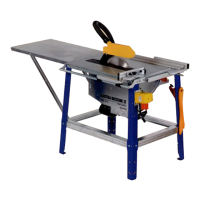
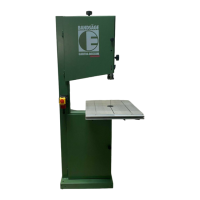




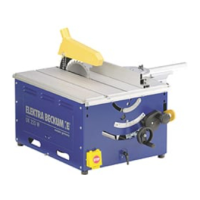

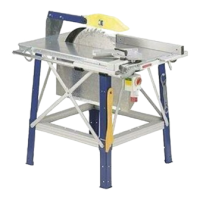
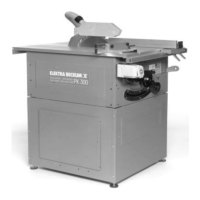
